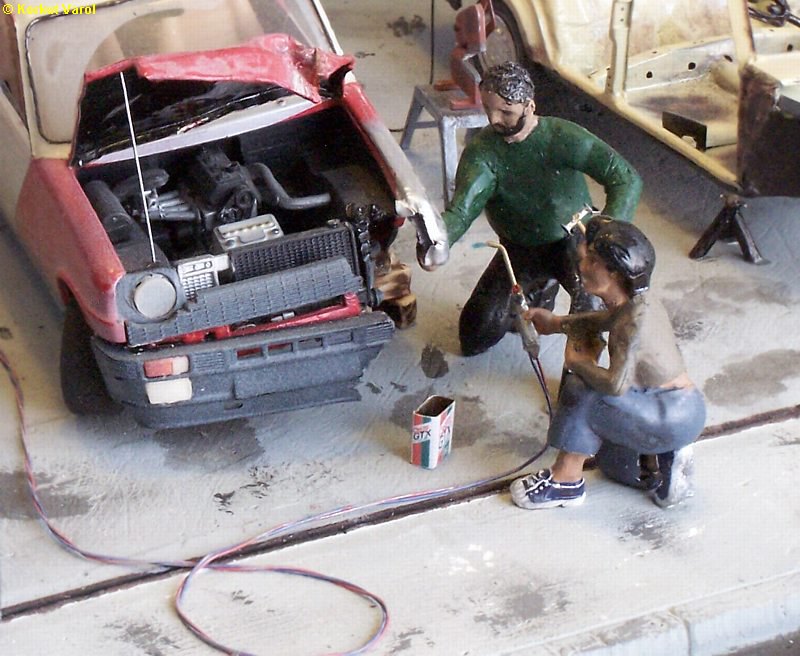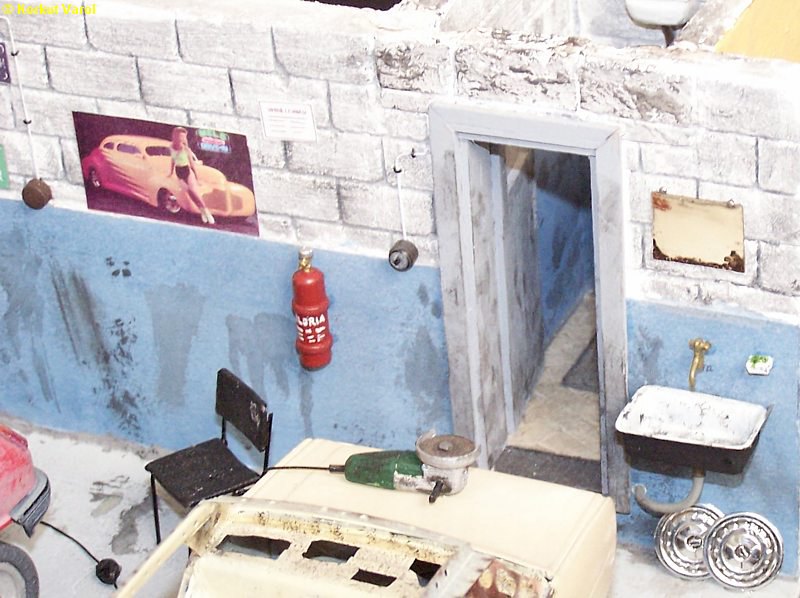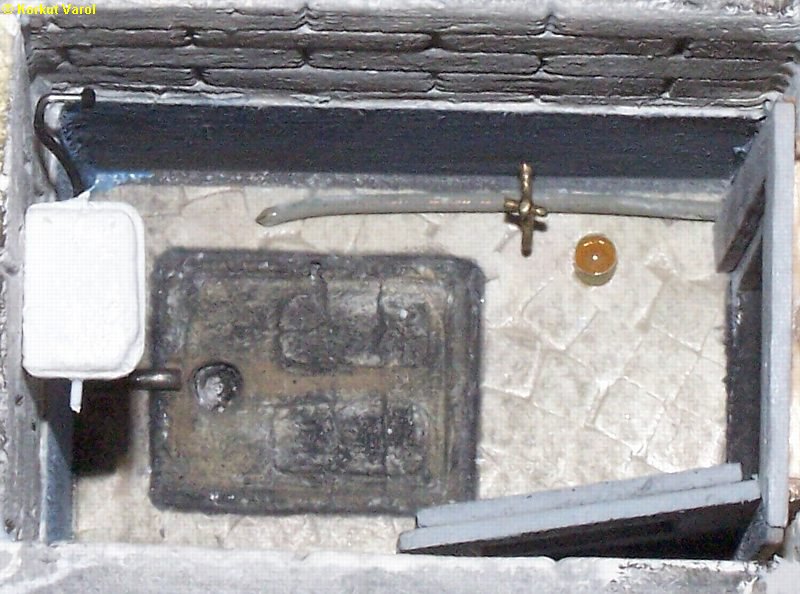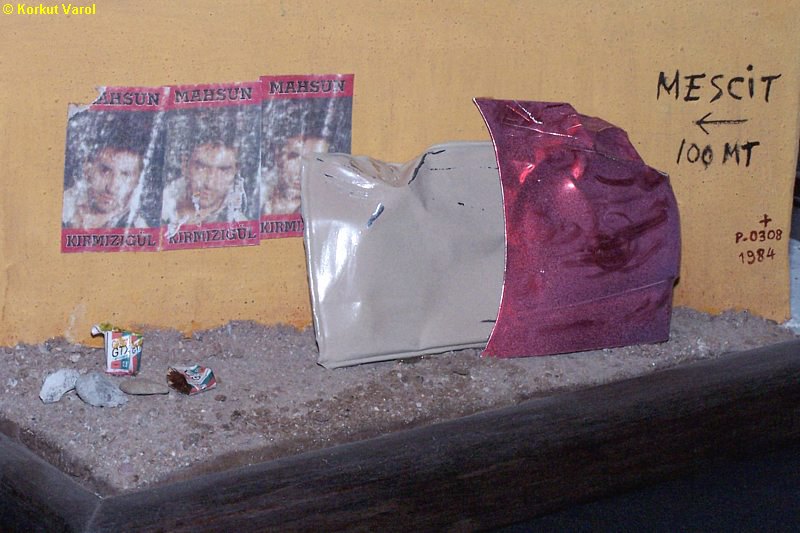Build Period:
October 1996 - January 1997 | CAR BODY REPAIR SHOP | 
|
.
Page 1 / 2
Now,
here is a typical car body
repair shop that you may see in Turkey. The shops are usually in a
mess;
you can rarely find a workshop that is neat , tidy and clean. In other
words, the workshops of authorized services are tidy and clean ; most
of
the rest look like this typical example that I built.
This
diorama uses only the
ESCI- 1/24 Renault 5 as a kit item ; in fact, the hood and the left
fender
are built of aluminium sheet and given a crushed form .
The
rest of the diorama is
scratchbuilt. While you go on viewing the pictures, you will see what
sort
of materials are used for construction .
.
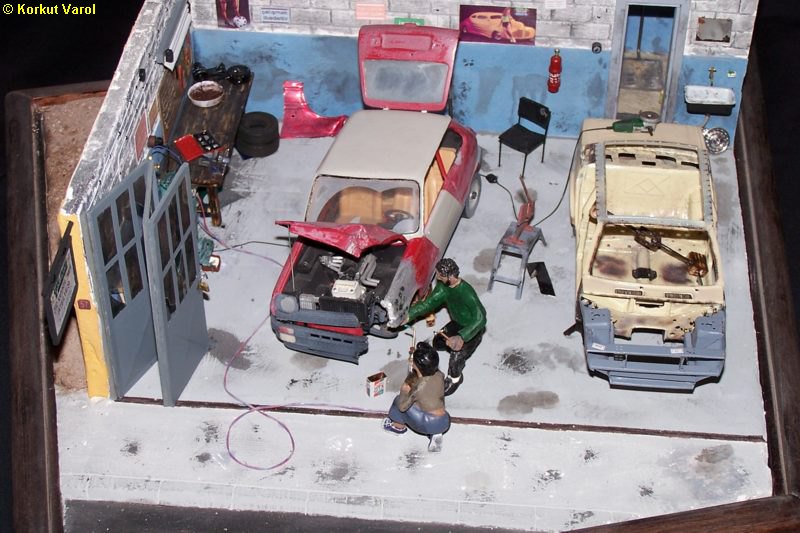
The
oxygen tank is made of
aluminium tubing that was once serving as a TV antenna and the
acetylene
tank a casing for a cigar - (NO...I
Do Not Smoke!!!!). The pressure gauges are
carved from rubber
, so as the vise. ( My poor daughter couldn't find it in her
schoolbag
next day!)
The
walls are from 12 mm
thick gypsum boards and it was very easy to etch contours on it to give
it a briquette look. The hardest part was to scrape off the cardboard
lining
to reach the gypsum. The blue painted region on the walls are the
un-scraped
cardboards which gave an identical look with a plastered and painted
wall.
It is also a common practice to leave the higher parts of the walls
unplastered
and natural in those modest shops.
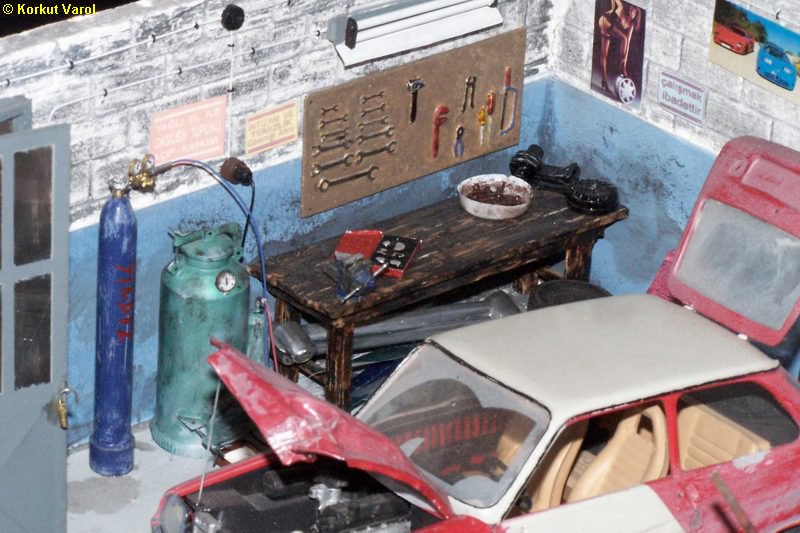
 |
Here you see
the close-up views of the vise and the dirty plastic tray containing
rusty
bolts. The handle of the vise and the bolts are made of pins. The rusty
effect was given by first heating the pins on an open fire to a black
state
, then dry brushing . By the way, the tray is from the packing of a
medicine
pill. The workbench is from balsa, burned locally with the tip of a
soldering
iron to give the aged effect. |
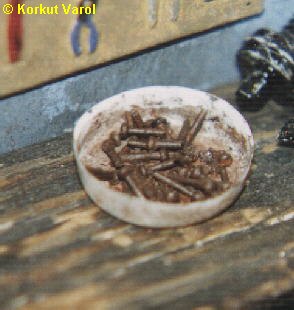 |
.
Here
the master and his apprentice
are on their work to repair a damaged Renault 5 . The master is made of
a brass wire skeleton covered with a putty composed of flour,salt and
water.
The apprentice was once the Alaaddin of Disney Products holding the
magic
lamp in his hand. That figure was carved out to be what you see above.
What a fall
for him! I wonder if he remembers those good
old days when that torch was the magic lamp...
By
the way, I hereby strongly
protest all the
manufacturers for producing so many 1/35 figures and so few 1/24
figures.
Do we have to compose all of our dioramas on military basis?
Those
dirts caused by spilled
oils in real life are caused by the same thing over here - drops of oil
from my car's oil sump. No paint would look more real.
This
FIAT 131 has had a big
impact at the front , so brand new front panels are being assembled on
it. The crash had also an effect on the right B-post, so it is forced
back
in place by the aid of a screw jack with wooden blocks on both ends in
order not to over-stress the metal.The roof has also been removed due
to
the deformation caused by the B-post displacement (which you will see
it
is thrown outside the shop in the oncoming pics.)
This
item is made of 0.20
mm thick brass sheet metal. In general, solder is used to join the
parts;
however, when solder is precluded to leave unmachinable residue around
the joint, then cyanoacrylate joining is used.

 | Here you see a closer view
of the B-post. This item is manufactured by casting lead and machining.
It is then soldered into place and joints are remachined for a good fit. |
This
close-up shows details
on the back wall of the shop. The poster is reduced to 1/24 scale on a
color copier . The electric switch near the toilet door is carved out
of
a BC-108 transistor. The tap is out of brass wire joined with solder
and
machined. The washbasin is made of 0.2 mm sheet brass, having
considerable
filling with solder and as much machining.
The
grinder body is of balsa
block, the shield of 0.2mm sheet brass and the disc being a worn-out
remainder
of the Dremel! That means it still works after it has finished its
duty!..
Now
you see a better view
of the workbench, the oxy-acetylene welding set, the tool-hanger plate
on the wall. The tools are embossed on a 0.2mm aluminium sheet (that is
the hanger plate) and painted to give the realistic impression. The
doors
are cut from acetate sheet, formed, given a peripheral profile with
balsa
bars and painted. Though not clear in the pic, the "glasses" are broken
occasionally and given a tint to duplicate the never-cleaned glasses of
such a workshop.
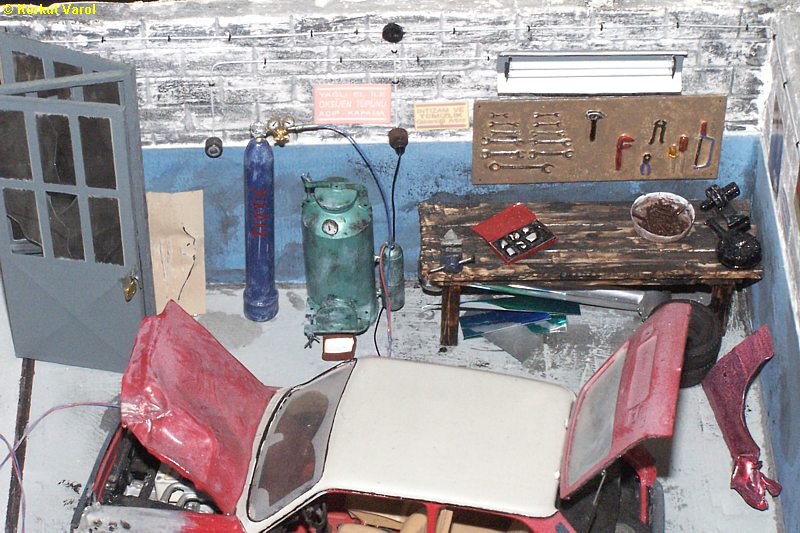
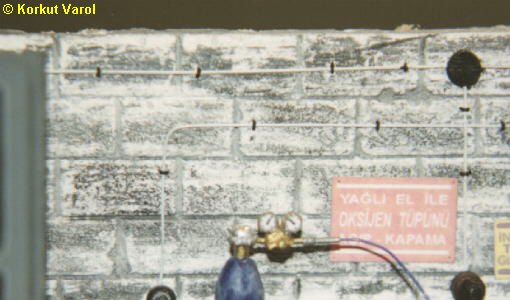 | This photo shows the wiring
detail on the walls. The cables are copper wires painted white, and
they
are held on the walls by the U-shaped pins painted black that are
inserted
in the walls.
That writing is a reminder
telling not to open or close the oxygen valve with oily hands. |
This
is the view of the WC
from above. In Turkey, the toilets are mostly the a
la Turca
type - that is, you do not sit on the closet but simply crouch. This
type
is claimed to be more hygienic for public places since your body has no
physical contact with the environment. That might be true - if only
people
cared about cleanness! This thing here is not manufactured from ceramic
clay, instead, it is cast from mosaic concrete. This yields a cheaper
product
that ends up with extensive use in such places. Its aged effect is
given
by dry brushing mustard tone over the blackened stone. The discharge of
the wash-basin goes through a plastic hose towards near the hole of the
toilet (Minimization of plumbing!). On the left wall protrudes the
water
tap with a tin can beside it; together which serve for cleaning
oneself.
Sorry - no tissue papers can be met!!
You don't use underwear made
of non-absorbing material, do you???
Why
build walls and leave
them empty? Three posters of a famous Turkish folk singer have been
pasted
on the wall - however, updating service does not seem to be dynamic
enough
since the posters have faded and torn... These posters were also scaled
down with a color copier and sanded very fine while resting on a smooth
and irregular surface.
The
ground around is real
ground , stuck in place with the common white furniture glue.Moist
effects
are made by airbrushing gloss lacquer. The roof of the FIAT 131 inside
is leaning against the wall with the hood of a Volvo 850. Both are made
of aluminium sheets. The thrown-away Castrol GTX oil cans are made of
paper.

|
|
|
|

|





